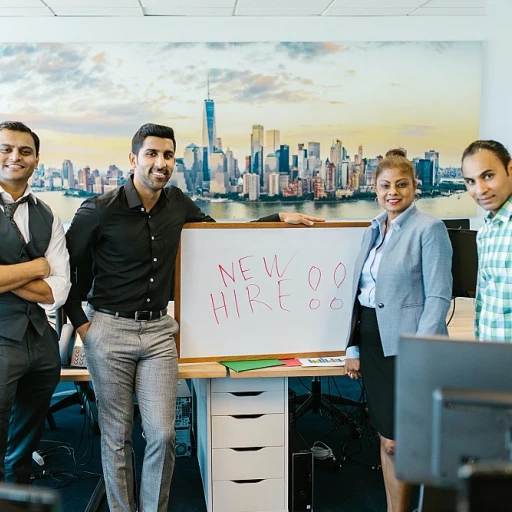Understanding the Need for Reskilling
The Urgent Necessity for New Skills
With the rapid pace of technological advancement, businesses are feeling the heat to keep their workforce equipped with the latest skills. It's a situation that's impacting industries across the board, compelling companies to invest in reskilling their employees. But why is this so important?
Organizations are facing what many call a "skills gap." This gap emerges when the skills of the current workforce don't match the needs of the job market—an issue that's not just about the skills themselves but also about keeping employees engaged and satisfied in their roles.
When employees perceive that they are growing and developing professionally, their job satisfaction increases significantly. And when job satisfaction goes up, so does employee retention. But ignoring this gap can lead to employees feeling stuck, unchallenged, or undervalued—potentially driving them to seek opportunities elsewhere.
The Game Changer for Employee Engagement
Reskilling provides a transformative opportunity for internal mobility within organizations, acting as a catalyst for discovering top talent from within. When businesses offer continuous learning opportunities, they're not just filling skill gaps; they're giving their team a chance to evolve and contribute in new ways. This initiative turns employees into true assets, capable of adapting to changes rather than being left behind.
Reskilling is not just about the skills one can add to their resume, but about creating a culture of learning that permeates through the organization. It’s about igniting enthusiasm by providing pathways for employee development and engagement. Employers who invest in such training programs tend to see increased loyalty, motivation, and creativity among their teams—outcomes that have a direct impact on performance and retention.
In summary, the necessity for reskilling is clear as it aligns with both workforce development and business growth strategies. Consider it a strategic move not only to meet the demands of tomorrow but also to see it as a "pathway to economic prosperity." Understanding this need sets the groundwork for seeing how reskilling connects directly with employee retention in further discussions.
The Connection Between Reskilling and Employee Retention
Boosting Retention through Employee Reskilling
Reskilling isn't just some corporate buzzword—it's a strategic key to employee retention. Think of it as an investment in the future of both the worker and the company. When employees see their skills being nurtured and developed, they feel valued, boosting their attachment to the organization. This sentiment echoes through the business world, where high employee turnover can have considerable costs. Retention, after all, saves on recruiting and training new hires, ensuring seamless continuity in business operations.
Consider a tale from a successful software company that embarked on reskilling its employees in new coding languages. They offered flexible training programs tailored to individual skill gaps, promoting these employees from within instead of hiring from outside. Not only did this move fill technical gaps, but it also cultivated a sense of career growth among the team, enhancing job satisfaction and loyalty.
Does Reskilling Really Work?
Sure, there's skepticism—"Does reskilling really keep people around?" you might wonder. The answer? Resounding yes. Reskilling programs that address workforce gaps directly connect with employee retention rates. A report by LinkedIn devotes significant attention to this correlation, showing that companies investing in learning development see 50% lower turnover. Internal mobility, where talent can move up the ranks, keeps ambition alive while satisfying organization needs.
Success Stories: A Practical Dive
Let’s delve into practical success examples. Take a multinational retail company that integrated reskilling initiatives targeting unemployed workers entering e-commerce. They aligned training programs with employees' existing skills and desired career paths. Enjoying increased loyalty, the company reported a noticeable drop in turnover rates, proving that reskilling can indeed act as a pathway to economic prosperity.
Still not convinced? Consider another tale from the logistics industry where job satisfaction soared after implementing reskilling sessions aimed at closing skill gaps in customer service. With improved abilities, workers felt empowered, leading to a more committed and engaged workforce.
To learn more about how reskilling can pave the way to economic wellbeing, check out our detailed post that dives deep into this subject.
So, reskilling doesn’t just fill skill gaps—it builds more loyal, dynamic teams ready for the challenges of today’s business world.
Implementing Effective Reskilling Programs
Crafting Strategies for Upskilling and Growth
When you're looking to keep your top talent around, you've got to ensure they're growing and learning. It's like gardening, right? You want your flowers - your employees - to flourish, so what do you do? You nurture them. This nurturing can be done through effective reskilling programs. A good reskilling program doesn’t happen by accident. It starts with the company really understanding where the skill gaps are. A gap analysis is essential to identify the areas in which employees can grow. Analyzing which skills your workforce currently lacks and which talents will be needed down the road sets the stage for targeted employee development. Think of it as preparing an athlete for the Olympics. You're identifying the training they need to get to the top.Setting Clear Goals and Objectives
Employee reskilling isn’t just about plugging holes. It's about being strategic and knowing what skills are crucial for the future of the business. Set clear goals. Whether it's becoming fluent in digital tools or honing interpersonal skills for leadership roles, clarity is key. Employees should know exactly what they're aiming for, so they can hit those targets with precision.Utilizing Tailored Training Programs
Training programs shouldn't be one-size-fits-all. Customization is king. Different employees will have different learning preferences and starting points. Some might excel in a classroom, while others thrive with hands-on, project-based learning. Reskilling initiatives need to consider these differences to maximize effectiveness. Online courses, workshops, webinars, and peer-to-peer learning sessions are all options that can be mixed and matched. The right blend will keep your team engaged and motivated, boosting employee engagement through reskilling, which you can read more about here.Encouraging Internal Mobility
Internal mobility is another strategy that shouldn't be overlooked. When employees see a career path within their current company, they're more likely to stay put. Create pathways for career progression that align with your reskilling programs. This not only maximizes the return on investment for training but also boosts job satisfaction and retention.Fostering a Culture of Continuous Learning
Lastly, for reskilling to really stick, build a culture of continuous learning. A company that fosters ongoing growth shows its employees that their development is a long-term investment. When the culture is one of learning and upskilling, employees are more willing to try new things, knowing that their organization supports them. Remember, an engaged workforce is a loyal workforce, and reskilling plays a big part in cementing this loyalty. Building these programs takes resources and commitment, but the payoff is worth it.Overcoming Challenges in Reskilling
Facing the Hurdles of Reskilling
Reskilling isn't always a walk in the park. Companies often stumble upon roadblocks when trying to implement effective programs. Let's break down some of these challenges and see how businesses can tackle them head-on.
Identifying Skills Gaps
Before diving into reskilling, it's essential to know where the gaps are. Conducting a thorough gap analysis can pinpoint where employees need training. Without this, efforts can be misdirected, wasting time and resources. Engaging employees in this process can also boost their involvement and commitment to learning.
Creating a Culture of Continuous Learning
For reskilling to work, a company must foster an environment where learning and development are part of the daily grind. This means encouraging employees to embrace new skills and supporting them through training programs. When a team sees that their growth is valued, their loyalty to the company strengthens.
Overcoming Resistance to Change
Change can be scary, and not all employees are eager to jump on the reskilling bandwagon. Clear communication about the benefits of reskilling programs can help ease fears. Sharing success stories of colleagues who have thrived after upskilling can also motivate hesitant workers to take the plunge.
Allocating Resources Wisely
Reskilling requires investment, both in terms of money and time. Companies need to ensure they have the budget and resources to support training initiatives. Partnering with learning platforms or industry experts can offer cost-effective solutions while providing top-notch training for employees.
Measuring Success and Adjusting Programs
Once reskilling programs are in place, it's crucial to track their effectiveness. This involves setting clear goals and metrics to evaluate success. Regular feedback from employees can highlight areas for improvement, ensuring that the programs remain relevant and impactful.
In tackling these challenges, businesses not only improve their workforce's skills but also enhance employee retention. A well-executed reskilling initiative can transform a company's talent pool, making it more adaptable and resilient in the face of change.
Measuring the Impact of Reskilling on Retention
Tracking Progress and Success
Measuring the impact of reskilling on employee retention isn't just about numbers; it's about seeing real change in the workplace. Companies need to look at how reskilling programs are helping employees grow and stay engaged. This involves tracking progress and success in a way that reflects both personal and professional development.
Using Feedback and Surveys
One effective way to gauge the impact of reskilling is through regular feedback and surveys. Employees can provide insights into how new skills are helping them in their roles and what areas might need more focus. This feedback loop ensures that reskilling initiatives are aligned with the needs of the workforce and can highlight areas for improvement.
Analyzing Retention Rates
Retention rates are a clear indicator of how well reskilling is working. By comparing retention rates before and after implementing reskilling programs, organizations can see if there's a positive trend. If employees are staying longer, it's a sign that the investment in their development is paying off.
Monitoring Internal Mobility
Internal mobility is another important metric. When employees have the opportunity to move into new roles within the company, it shows that reskilling is creating a more versatile workforce. This not only benefits the employees but also helps the company fill skill gaps without having to look outside for talent.
Evaluating Job Satisfaction
Job satisfaction surveys can also provide valuable insights. When employees feel their skills are being developed and valued, their job satisfaction tends to increase. This, in turn, boosts morale and reduces turnover, further strengthening employee loyalty.
Case Studies and Real-Life Examples
Real-life examples and case studies can offer powerful evidence of the benefits of reskilling. For instance, a tech company might share how reskilling programs helped them retain top talent by allowing employees to transition into roles that matched their new skills. These stories can inspire other organizations to invest in similar initiatives.
By focusing on these metrics and stories, companies can not only measure the success of their reskilling efforts but also continue to improve and adapt their programs to meet the evolving needs of their workforce.
Future Trends in Reskilling and Employee Retention
What's Next for Reskilling and Retention?
As businesses continue to focus on reskilling and upskilling their employees, the future holds promising trends that are set to redefine how we view employee development and retention. With the rapid pace of technological change and evolving job markets, companies are finding new ways to stay ahead of the curve and ensure their workforce is prepared for what's next.
AI and Automation in Reskilling
Artificial intelligence and automation are not just buzzwords; they are becoming integral to reskilling programs. Companies are leveraging AI to personalize training and identify skills gaps more efficiently. AI-driven platforms can recommend learning paths tailored to individual employees, making training more effective and engaging. This not only boosts employee retention but also enhances job satisfaction by aligning skills with career aspirations.
Emphasis on Transferable Skills
As industries evolve, the focus is shifting towards transferable skills that allow workers to adapt to various roles. Skills like problem-solving, critical thinking, and adaptability are becoming essential. Companies that encourage continuous learning and development of these skills will find their teams more resilient and capable of handling future challenges.
Blending Learning and Work
The line between learning and working is blurring. Organizations are integrating learning development into daily work processes, allowing employees to learn on the job. This approach not only saves time but also reinforces new skills through practical application. Such initiatives foster a culture of continuous learning and keep top talent engaged.
Internal Mobility as a Retention Strategy
Providing opportunities for internal mobility is becoming a cornerstone of employee retention. By reskilling employees for different roles within the organization, companies can retain talent and reduce turnover. This approach not only fills skills gaps but also motivates employees by offering new challenges and career paths.
As we look to the future, it's clear that reskilling initiatives will play a crucial role in maintaining a competitive edge. By embracing these trends, businesses can not only improve employee engagement but also ensure their workforce is ready for the jobs of tomorrow.








